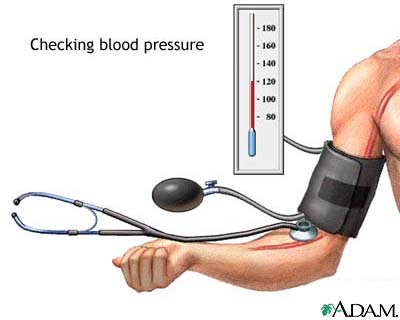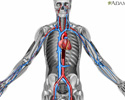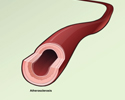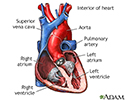Aging changes in the heart and blood vessels
Heart disease - aging; Atherosclerosis - aging
Information
Some changes in the heart and blood vessels normally occur with age. However, many other changes that are common with aging are due to modifiable factors. If not treated, these can lead to heart disease.
BACKGROUND
The heart has two sides. The right side pumps blood to the lungs to receive oxygen and get rid of carbon dioxide. The left side pumps oxygen-rich blood to the body.
Blood flows out of the heart through arteries, which branch out and get smaller and smaller as they go into the tissues. In the tissues, they become tiny capillaries.
Capillaries are where the blood gives up oxygen and nutrients to the tissues, and receives carbon dioxide and wastes back from the tissues. Then, the vessels begin to collect together into larger and larger veins, which return blood to the heart.
AGING CHANGES
Heart:
-
The heart has a natural pacemaker system that controls the heartbeat. Some of the pathways of this system may develop fibrous tissue and fat deposits. The natural pacemaker (the SA node) loses some of its cells. These changes may result in a slightly slower
heart rate
.
Heart rate
The pulse is the number of heartbeats per minute.
 ImageRead Article Now Book Mark Article
ImageRead Article Now Book Mark Article - A slight increase in the size of the heart, especially the left ventricle, is not uncommon. The heart wall thickens, so the amount of blood that the chamber can hold may actually decrease despite the increased overall heart size. The heart may fill more slowly.
-
Heart changes cause the
ECG
of a normal, healthy older person to be slightly different than the ECG of a healthy younger adult. Abnormal rhythms (
arrhythmias
), such as
atrial fibrillation
, are more common in older people. They may be caused by heart disease.
ECG
An electrocardiogram (ECG) is a test that records the electrical activity of the heart.
 ImageRead Article Now Book Mark Article
ImageRead Article Now Book Mark ArticleArrhythmias
An arrhythmia is a disorder of the heart rate (pulse) or heart rhythm. The heart can beat too fast (tachycardia), too slow (bradycardia), or irregul...
 ImageRead Article Now Book Mark Article
ImageRead Article Now Book Mark ArticleAtrial fibrillation
Atrial fibrillation or flutter is a common type of abnormal heartbeat. The heart rhythm is fast and most often irregular.
 ImageRead Article Now Book Mark Article
ImageRead Article Now Book Mark Article -
Normal changes in the heart include deposits of the "aging pigment,"
lipofuscin
. The heart muscle cells degenerate slightly. The valves inside the heart, which control the direction of blood flow, thicken and become stiffer. A heart murmur caused by valve stiffness is fairly common in older people.
Lipofuscin
Lipofuscin is a brownish pigment left over from the breakdown and absorption of damaged blood cells. Lipofuscin is found in heart muscle and smooth m...
 ImageRead Article Now Book Mark Article
ImageRead Article Now Book Mark Article
Blood vessels:
- Receptors called baroreceptors monitor the blood pressure and make changes to help maintain a fairly constant blood pressure when a person changes positions or is doing other activities. The baroreceptors become less sensitive with aging. This may explain why many older people have orthostatic hypotension, a condition in which the blood pressure falls when a person goes from lying or sitting to standing. This causes dizziness because there is less blood flow to the brain.
- The capillary walls thicken slightly. This may cause a slightly slower rate of exchange of nutrients and wastes.
- The main artery from the heart (aorta) becomes thicker, stiffer, and less flexible. This is probably related to changes in the connective tissue of the blood vessel wall. This makes the blood pressure higher and makes the heart work harder, which may lead to thickening of the heart muscle (hypertrophy). The other arteries also thicken and stiffen. In general, most older people have a moderate increase in blood pressure.
Blood:
- The blood itself changes slightly with age. Normal aging causes a reduction in total body water. As part of this, there is less fluid in the bloodstream, so blood volume decreases.
- The speed with which red blood cells are produced in response to stress or illness is reduced. This creates a slower response to blood loss and anemia.
-
Most of the white blood cells stay at the same levels, although certain white blood cells important to immunity (
neutrophils
) decrease in their number and ability to fight off bacteria. This reduces the ability to resist infection.
Neutrophils
The immune response is how your body recognizes and defends itself against bacteria, viruses, and substances that appear foreign and harmful....
 ImageRead Article Now Book Mark Article
ImageRead Article Now Book Mark Article
EFFECT OF CHANGES
Normally, the heart continues to pump enough blood to supply all parts of the body. However, an older heart may not be able to pump blood as well when you make it work harder.
Some of the things that make your heart work harder are:
- Certain medicines
- Emotional stress
- Physical exertion
- Illness
- Infections
- Injuries
COMMON PROBLEMS
-
Angina
(chest pain caused by temporarily reduced blood flow to the heart muscle), shortness of breath with exertion, and
heart attack
can result from coronary artery disease.
Angina
Angina is a type of chest discomfort or pain due to poor blood flow through the blood vessels (coronary vessels) of the heart muscle (myocardium). Th...
Read Article Now Book Mark ArticleHeart attack
Most heart attacks are caused by a blood clot that blocks one of the coronary arteries. The coronary arteries bring blood and oxygen to the heart. ...
 ImageRead Article Now Book Mark Article
ImageRead Article Now Book Mark Article - Abnormal heart rhythms (arrhythmias) of various types can occur.
-
Anemia
may occur, possibly related to malnutrition, chronic infections, blood loss from the gastrointestinal tract, or as a complication of other diseases or medicines.
Anemia
Anemia is a condition in which the body does not have enough healthy red blood cells. Red blood cells provide oxygen to body tissues. Different type...
 ImageRead Article Now Book Mark Article
ImageRead Article Now Book Mark Article -
Arteriosclerosis
(hardening of the arteries) is very common. Fatty plaque deposits inside the blood vessels cause them to narrow and totally block blood vessels.
Arteriosclerosis
Hardening of the arteries, also called atherosclerosis, occurs when fat, cholesterol, and other substances build up in the walls of arteries. These ...
 ImageRead Article Now Book Mark Article
ImageRead Article Now Book Mark Article -
Congestive
heart failure
is also very common in older people. In people older than 75, congestive heart failure occurs 10 times more often than in younger adults.
Heart failure
Heart failure is a condition in which the heart is no longer able to pump oxygen-rich blood to the rest of the body efficiently. This causes symptom...
 ImageRead Article Now Book Mark Article
ImageRead Article Now Book Mark Article -
Coronary artery disease
is fairly common. It is often a result of arteriosclerosis.
Coronary artery disease
Stable angina is chest pain or discomfort that most often occurs with activity or emotional stress. Angina is due to poor blood flow through the blo...
 ImageRead Article Now Book Mark Article
ImageRead Article Now Book Mark Article - High blood pressure and orthostatic hypotension are more common with older age. Older people on blood pressure medicines need to work with their doctor to find the best way to manage their high blood pressure. This is because too much medicine may cause low blood pressure and could lead to a fall.
-
Heart valve diseases are fairly common.
Aortic stenosis
, or narrowing of the aortic valve, is the most common valve disease in older adults.
Aortic stenosis
The aorta is the main artery that carries blood out of the heart to the rest of the body. Blood flows out of the heart and into the aorta through th...
 ImageRead Article Now Book Mark Article
ImageRead Article Now Book Mark Article -
Transient ischemic attacks (
TIA
) or strokes can occur if blood flow to the brain is disrupted.
TIA
A transient ischemic attack occurs when blood flow to a part of the brain stops for a brief time. A person will have stroke-like symptoms for up to ...
 ImageRead Article Now Book Mark Article
ImageRead Article Now Book Mark Article
Other problems with the heart and blood vessels include the following:
-
Blood clots
Blood clots
Blood clots are clumps that occur when blood hardens from a liquid to a solid. A blood clot that forms inside one of your veins or arteries is calle...
 ImageRead Article Now Book Mark Article
ImageRead Article Now Book Mark Article -
Deep vein thrombosis
Deep vein thrombosis
Deep vein thrombosis (DVT) is a condition that occurs when a blood clot forms in a vein deep inside a part of the body. It mainly affects the large ...
 ImageRead Article Now Book Mark Article
ImageRead Article Now Book Mark Article -
Thrombophlebitis
Thrombophlebitis
Thrombophlebitis is swelling (inflammation) of a vein. A blood clot (thrombus) in the vein can cause this swelling.
 ImageRead Article Now Book Mark Article
ImageRead Article Now Book Mark Article -
Peripheral vascular disease
, resulting in intermittent pain in the legs when walking (claudication)
Peripheral vascular disease
Peripheral artery disease (PAD) is a condition of the blood vessels that supply the legs and feet. It leads to narrowing and hardening of the arteri...
 ImageRead Article Now Book Mark Article
ImageRead Article Now Book Mark Article -
Varicose veins
Varicose veins
Varicose veins are swollen, twisted, and enlarged veins that you can see under the skin. They are often red or blue in color. They most often appea...
 ImageRead Article Now Book Mark Article
ImageRead Article Now Book Mark Article -
Aneurysms
may develop in one of the major arteries from the heart or in the brain. Aneurysms are an abnormal widening or ballooning of a part of an artery due to weakness in the wall of the blood vessel. If an aneurysm bursts it may cause bleeding and death.
Aneurysms
An aneurysm is an abnormal widening or ballooning of a part of an artery due to weakness in the wall of the blood vessel.
 ImageRead Article Now Book Mark Article
ImageRead Article Now Book Mark Article
PREVENTION
- You can help your circulatory system (heart and blood vessels). Heart disease risk factors that you have some control over include high blood pressure, cholesterol levels, diabetes, obesity, and smoking.
-
Eat a heart-healthy diet with reduced amounts of saturated fat and cholesterol, and control your weight. Follow your health care provider's recommendations for treating high blood pressure,
high cholesterol
or diabetes. Reduce or stop smoking.
High cholesterol
Cholesterol is a fat (also called a lipid) that your body needs to work properly. Too much bad cholesterol can increase your chance of getting heart...
 ImageRead Article Now Book Mark Article
ImageRead Article Now Book Mark Article - Men between the ages of 65 to 75 who have ever smoked should be screened for aneurysms in their abdominal aorta.
Get more exercise:
- Exercise may help prevent obesity, and it helps people with diabetes control their blood sugar.
- Exercise may help you maintain your abilities as much as possible, and it reduces stress.
- Moderate exercise is one of the best things you can do to keep your heart, and the rest of your body, healthy. Consult with your provider before beginning a new exercise program. Exercise moderately and within your capabilities, but do it regularly.
- People who exercise often have less body fat and smoke less than people who do not exercise. They also tend to have fewer blood pressure problems and less heart disease.
Have regular check-ups for your heart:
- Have your blood pressure checked every year. If you have diabetes, heart disease, kidney problems, or certain other conditions, your blood pressure may need to be monitored more closely.
- If your cholesterol level is normal, have it rechecked every 5 years. If you have diabetes, heart disease, kidney problems, or certain other conditions, your cholesterol may need to be monitored more closely.
- If you are an older man (between the ages of 65 to 75) and you have a history of smoking, you should be screened for aneurysms in one of the major arteries of the heart.
References
James PA, Oparil S, Carter BL, et al. 2014 evidence-based guideline for the management of high blood pressure in adults: report from the panel members appointed to the Eighth Joint National Committee (JNC 8). JAMA . 2014;311(5):507-520. PMID: 24352797 www.ncbi.nlm.nih.gov/pubmed/24352797 .
LeFevre ML; US Preventive Services Task Force. Screening for abdominal aortic aneurysm: US Preventive Services Task Force recommendation statement. Ann Intern Med . 2014;161(4):281-90. PMID: 24957320 www.ncbi.nlm.nih.gov/pubmed/24957320 .
Schwartz JB, Zipes DP. Cardiovascular disease in the elderly In: Mann DL, Zipes DP, Libby P, Bonow RO, Braunwald E, eds. Braunwald's Heart Disease: A Textbook of Cardiovascular Medicine . 10th ed. Philadelphia, PA: Elsevier Saunders; 2015:chap 76.
Stone NJ, Robinson JG, Lichtenstein AH, et al. 2013 ACC/AHA guideline on the treatment of blood cholesterol to reduce atherosclerotic cardiovascular risk in adults: a report of the American College of Cardiology/American Heart Association Task Force on Practice Guidelines. Circulation . 2014;129(25 Suppl 2):S1-S45. PMID: 24222016 www.ncbi.nlm.nih.gov/pubmed/24222016 .
Walston JD. Common clinical sequelae of aging. In: Goldman L, Schafer AI, eds. Goldman-Cecil Medicine . 25th ed. Philadelphia, PA: Elsevier Saunders; 2016:chap 25.
-
Blood flow
Animation
-
Atherosclerosis overview
Animation
-
Taking your carotid pulse - illustration
The carotid arteries take oxygenated blood from the heart to the brain. The pulse from the carotids may be felt on either side of the front of the neck just below the angle of the jaw. This rhythmic "beat" is caused by varying volumes of blood being pushed out of the heart toward the extremities.
Taking your carotid pulse
illustration
-
Circulation of blood through the heart - illustration
The heart is a large muscular organ which constantly pushes oxygen-rich blood to the brain and extremities and transports oxygen-poor blood from the brain and extremities to the lungs to gain oxygen. Blood comes into the right atrium from the body, moves into the right ventricle and is pushed into the pulmonary arteries in the lungs. After picking up oxygen, the blood travels back to the heart through the pulmonary veins into the left atrium, to the left ventricle and out to the body's tissues through the aorta.
Circulation of blood through the heart
illustration
-
Radial pulse - illustration
Arteries carry oxygenated blood away from the heart to the tissues of the body. Veins carry blood depleted of oxygen from the same tissues back to the heart. The arteries are the vessels with the "pulse," a rhythmic pushing of the blood in the heart followed by a refilling of the heart chamber. To determine heart rate, one counts the beats at a pulse point like the inside of the wrist for 10 seconds, and multiplies this number by 6. This is the per-minute total.
Radial pulse
illustration
-
Normal heart anatomy (cut section) - illustration
The normal heart viewed so that major valves can be seen.
Normal heart anatomy (cut section)
illustration
-
Effects of age on blood pressure - illustration
Blood vessels become less elastic with age. The average blood pressure increases from 120/70 to 150/90 and may persist slightly high, even if treated. The blood vessels respond more slowly to a change in body position.
Effects of age on blood pressure
illustration
-
Taking your carotid pulse - illustration
The carotid arteries take oxygenated blood from the heart to the brain. The pulse from the carotids may be felt on either side of the front of the neck just below the angle of the jaw. This rhythmic "beat" is caused by varying volumes of blood being pushed out of the heart toward the extremities.
Taking your carotid pulse
illustration
-
Circulation of blood through the heart - illustration
The heart is a large muscular organ which constantly pushes oxygen-rich blood to the brain and extremities and transports oxygen-poor blood from the brain and extremities to the lungs to gain oxygen. Blood comes into the right atrium from the body, moves into the right ventricle and is pushed into the pulmonary arteries in the lungs. After picking up oxygen, the blood travels back to the heart through the pulmonary veins into the left atrium, to the left ventricle and out to the body's tissues through the aorta.
Circulation of blood through the heart
illustration
-
Radial pulse - illustration
Arteries carry oxygenated blood away from the heart to the tissues of the body. Veins carry blood depleted of oxygen from the same tissues back to the heart. The arteries are the vessels with the "pulse," a rhythmic pushing of the blood in the heart followed by a refilling of the heart chamber. To determine heart rate, one counts the beats at a pulse point like the inside of the wrist for 10 seconds, and multiplies this number by 6. This is the per-minute total.
Radial pulse
illustration
-
Normal heart anatomy (cut section) - illustration
The normal heart viewed so that major valves can be seen.
Normal heart anatomy (cut section)
illustration
-
Effects of age on blood pressure - illustration
Blood vessels become less elastic with age. The average blood pressure increases from 120/70 to 150/90 and may persist slightly high, even if treated. The blood vessels respond more slowly to a change in body position.
Effects of age on blood pressure
illustration
-
Heart failure
(In-Depth)
-
Exercise
(In-Depth)
-
Hawthorn
(Alt. Medicine)
-
Stress
(In-Depth)
-
Vitamins
(In-Depth)
-
Vitamin C (Ascorbic acid)
(Alt. Medicine)
-
Chronic obstructive pulmonary disease
(In-Depth)
-
Hypothyroidism
(In-Depth)
-
Skin wrinkles and blemishes
(In-Depth)
-
Sexual dysfunction
(Alt. Medicine)
Review Date: 8/22/2016
Reviewed By: Laura J. Martin, MD, MPH, ABIM Board Certified in Internal Medicine and Hospice and Palliative Medicine, Atlanta, GA. Also reviewed by David Zieve, MD, MHA, Isla Ogilvie, PhD, and the A.D.A.M. Editorial team.








